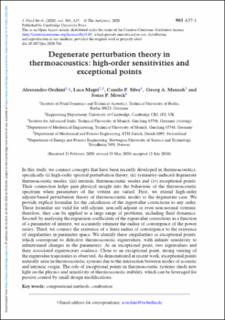| dc.contributor.author | Orchini, Alessandro | |
| dc.contributor.author | Magri, Luca | |
| dc.contributor.author | Silva, Camilo F. | |
| dc.contributor.author | Mensah, Georg | |
| dc.contributor.author | Moeck, Jonas | |
| dc.date.accessioned | 2021-03-01T12:19:48Z | |
| dc.date.available | 2021-03-01T12:19:48Z | |
| dc.date.created | 2020-10-05T13:58:25Z | |
| dc.date.issued | 2020 | |
| dc.identifier.citation | Journal of Fluid Mechanics. 2020, 903 . | en_US |
| dc.identifier.issn | 0022-1120 | |
| dc.identifier.uri | https://hdl.handle.net/11250/2730924 | |
| dc.description.abstract | In this study, we connect concepts that have been recently developed in thermoacoustics, specifically (i) high-order spectral perturbation theory, (ii) symmetry-induced degenerate thermoacoustic modes, (iii) intrinsic thermoacoustic modes and (iv) exceptional points. Their connection helps gain physical insight into the behaviour of the thermoacoustic spectrum when parameters of the system are varied. First, we extend high-order adjoint-based perturbation theory of thermoacoustic modes to the degenerate case. We provide explicit formulae for the calculation of the eigenvalue corrections to any order. These formulae are valid for self-adjoint, non-self-adjoint or even non-normal systems; therefore, they can be applied to a large range of problems, including fluid dynamics. Second, by analysing the expansion coefficients of the eigenvalue corrections as a function of a parameter of interest, we accurately estimate the radius of convergence of the power series. Third, we connect the existence of a finite radius of convergence to the existence of singularities in parameter space. We identify these singularities as exceptional points, which correspond to defective thermoacoustic eigenvalues, with infinite sensitivity to infinitesimal changes in the parameters. At an exceptional point, two eigenvalues and their associated eigenvectors coalesce. Close to an exceptional point, strong veering of the eigenvalue trajectories is observed. As demonstrated in recent work, exceptional points naturally arise in thermoacoustic systems due to the interaction between modes of acoustic and intrinsic origin. The role of exceptional points in thermoacoustic systems sheds new light on the physics and sensitivity of thermoacoustic stability, which can be leveraged for passive control by small design modifications. | en_US |
| dc.language.iso | eng | en_US |
| dc.publisher | Cambridge University Press | en_US |
| dc.rights | Navngivelse 4.0 Internasjonal | * |
| dc.rights.uri | http://creativecommons.org/licenses/by/4.0/deed.no | * |
| dc.title | Degenerate perturbation theory in thermoacoustics: high-order sensitivities and exceptional points | en_US |
| dc.type | Peer reviewed | en_US |
| dc.type | Journal article | en_US |
| dc.description.version | publishedVersion | en_US |
| dc.source.pagenumber | 30 | en_US |
| dc.source.volume | 903 | en_US |
| dc.source.journal | Journal of Fluid Mechanics | en_US |
| dc.identifier.doi | 10.1017/jfm.2020.586 | |
| dc.identifier.cristin | 1837113 | |
| dc.description.localcode | This is an Open Access article, distributed under the terms of the Creative Commons Attribution licence (http://creativecommons.org/licenses/by/4.0/), which permits unrestricted re-use, distribution, and reproduction in any medium, provided the original work is properly cited. doi:10.1017/jfm.2020.586 | en_US |
| cristin.ispublished | true | |
| cristin.fulltext | original | |
| cristin.qualitycode | 2 | |

